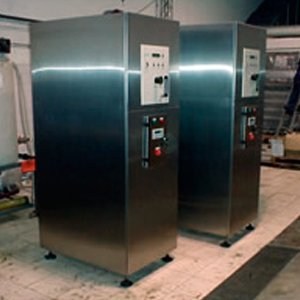Technologies > Ozonisation
Although synthetic ozone production was discovered around 130 years ago, significant progress where done only in the last few decades.
Modern generators producing at high concentrations with specific regular levels of energy consumption made from the ozone a viable chemical oxidation with a lot of applications. Product possibilities and/or ecologic improvements through ozone conventional disinfectant replacement – or mere by ozone introduction- are enormous, for example:
- In pharmaceutical industry for distribution loop and sanitization of pharmaceutical water quality.
- In high microbiologic and/or organic concentration waste treatment.
- In aquariums and breeding fish places, where there is high fish density concentration per cubic meter and it is important that infected water does not enter to the system.
- In all industries, where there is a water treatment system, for example: an entrance filter, chlorination unit, multimedia filter.
- In drinks industry (bottled water, sodas, beer, etc.), where water has to be treated and disinfected before it use.
- In packaging factories and freezing food, where the products have to be carefully washed and a huge amount of water is required.
Ozone production way
When oxygen molecules (O2) pass through a set composed by a high voltage electrode, a dielectric and an earth connected electrode, they are dissociated.
So, a high voltage with high frequency is applied to the electrodes. The plasma formed in the place between the electrodes is known as crown discharge and there, oxygen molecules dissociated and gather the ozone.
Ozone working way
The ozone is an unstable component that may act through a simple oxidation, where a molecule dissociates or by a reaction called “Criegee mechanism”, where three oxygen molecules are required. In many inorganic reactions only a single molecule atom takes part of the oxidation reaction, and the other two are emitted as molecular oxygen. Ozone reactions easily with no saturated organic components, adding three oxygen atoms to the double or triple ligature. In addition, ozone may act as a powerful disinfectant deactivating bacterias, fungus, virus, etc. by breaking it’s cell wall.
